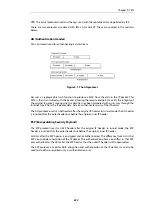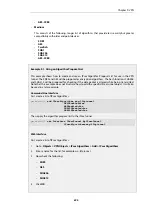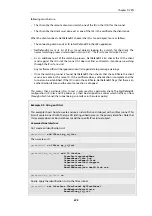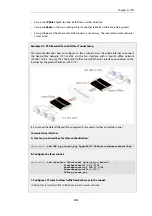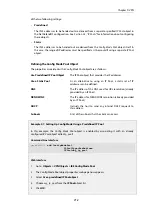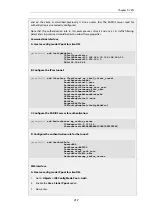
(specified by the advanced setting DPD Metric) then NetDefendOS sends
DPD-R-U-THERE
messages to the peer to determine if it is still reachable.
If the peer does not respond to these messages during a period of time (specified by the
advanced setting DPD Expire Time) then the peer is considered dead and the tunnel is
closed. NetDefendOS will then automatically try to re-establish the tunnel after a period of
time (specified by the advanced setting DPD Keep Time).
The advanced settings for DPD are described further in
Section 9.4.9, “IPsec Advanced Settings”
Although DPD is enabled by default, disabling it does not disable NetDefendOS responding
to
DPD-R-U-THERE
messages from a peer, since the IPsec standard requires this. However,
disabling DPD means that NetDefendOS will not send out its own
DPD-R-U-THERE
messages.
Note
Both Auto Establish and DPD could be used at the same time.
•
Tunnel Monitoring
NetDefendOS provides
tunnel monitoring
as an addition to DPD for monitoring the health of
an IPsec tunnel. Tunnel monitoring requires that an external host is available that is reachable
through the tunnel with ICMP ping messages. This feature is described further in
IPsec Tunnel Quick Start Sections
A quick start checklist of setup steps for these protocols in typical scenarios can be found in the
following sections in this document:
•
Section 9.2.1, “IPsec LAN-to-LAN with Pre-shared Keys”
•
Section 9.2.2, “IPsec LAN-to-LAN with Certificates”
•
Section 9.2.3, “IPsec Roaming Clients with Pre-shared Keys”
•
Section 9.2.4, “IPsec Roaming Clients with Certificates”
In addition to the quick start section, more explanation of tunnel setup is given below.
9.4.2. LAN-to-LAN Tunnels with Pre-shared Keys
A VPN can allow geographically distributed Local Area Networks (LANs) to communicate securely
over the public Internet. In a corporate context this means LANs at geographically separate sites
can communicate with a level of security comparable to that existing if they communicated
through a dedicated, private link.
Secure communication is achieved through the use of IPsec tunneling, with the tunnel extending
from the VPN gateway at one location to the VPN gateway at another location. The NetDefend
Firewall is therefore the implementer of the VPN, while at the same time applying normal
security surveillance of traffic passing through the tunnel. This section deals specifically with
setting up LAN-to-LAN tunnels created with a Pre-shared Key (PSK).
A number of steps are required to set up LAN-to-LAN tunnels with PSK:
•
Set up the VPN tunnel properties and include the Pre-Shared key.
Chapter 9: VPN
704
Summary of Contents for NetDefendOS
Page 30: ...Figure 1 3 Packet Flow Schematic Part III Chapter 1 NetDefendOS Overview 30 ...
Page 32: ...Chapter 1 NetDefendOS Overview 32 ...
Page 144: ...Chapter 2 Management and Maintenance 144 ...
Page 284: ...Chapter 3 Fundamentals 284 ...
Page 392: ...Chapter 4 Routing 392 ...
Page 419: ... Host 2001 DB8 1 MAC 00 90 12 13 14 15 5 Click OK Chapter 5 DHCP Services 419 ...
Page 420: ...Chapter 5 DHCP Services 420 ...
Page 573: ...Chapter 6 Security Mechanisms 573 ...
Page 607: ...Chapter 7 Address Translation 607 ...
Page 666: ...Chapter 8 User Authentication 666 ...
Page 775: ...Chapter 9 VPN 775 ...
Page 819: ...Chapter 10 Traffic Management 819 ...
Page 842: ...Chapter 11 High Availability 842 ...
Page 866: ...Default Enabled Chapter 13 Advanced Settings 866 ...
Page 879: ...Chapter 13 Advanced Settings 879 ...



